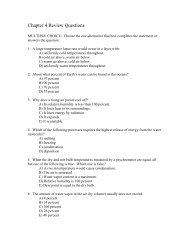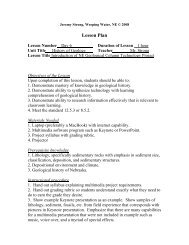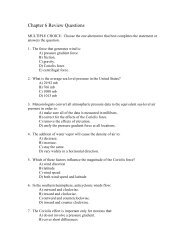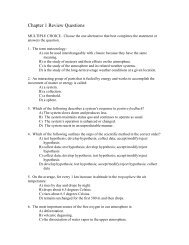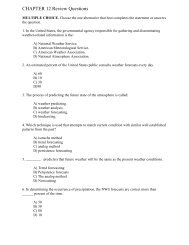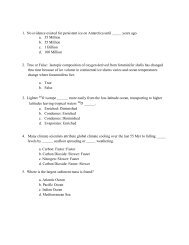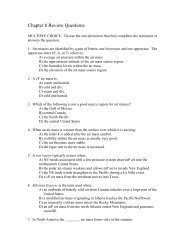CHAPTER 11 Review Questions.pdf
CHAPTER 11 Review Questions.pdf
CHAPTER 11 Review Questions.pdf
Create successful ePaper yourself
Turn your PDF publications into a flip-book with our unique Google optimized e-Paper software.
<strong>CHAPTER</strong> <strong>11</strong> <strong>Review</strong> <strong>Questions</strong><br />
MULTIPLE CHOICE. Choose the one alternative that best completes the statement or answers<br />
the question.<br />
1. The United States deadliest hurricane happened in 1900 in Galveston, Texas. Approximately<br />
how many deaths did the hurricane cause<br />
A) 1000<br />
B) 4000<br />
C) 2000<br />
D) 8000<br />
2. Which "famous" hurricane was the costliest in United States history<br />
A) Hurricane Diane<br />
B) Hurricane Hugo<br />
C) Hurricane Katrina<br />
D) Hurricane Floyd<br />
3. A hurricane must have sustained wind speeds of at least<br />
A) 84 miles per hour.<br />
B) 64 miles per hour.<br />
C) 94 miles per hour.<br />
D) 74 miles per hour.<br />
4. When occurring in the Atlantic Ocean they are known as hurricanes, what are they known as<br />
when occurring in the western Pacific<br />
A) cyclones<br />
B) tropical breezes<br />
C) tsunamis<br />
D) typhoons<br />
5. What are hurricanes known as in the Indian Ocean, including the Bay of Bengal and Arabian<br />
Sea<br />
A) tropical breezes<br />
B) tsunamis<br />
C) cyclones<br />
D) typhoons<br />
6. When a cyclone's strongest winds do not exceed 37 miles per hour it is called a:<br />
A) dust devil<br />
B) hurricane.<br />
C) tropical storm.<br />
D) tropical depression.<br />
E) tornado.
7. What is the single greatest advancement in tools used for observing tropical cyclones<br />
A) meteorological satellites<br />
B) aircraft reconnaissance<br />
C) data buoys<br />
D) radar<br />
8. What category of the scale of hurricane intensity is the strongest<br />
A) 20<br />
B) 1<br />
C) 10<br />
D) 5<br />
E) 3<br />
9. The very center of the storm is called the:<br />
A) eye wall..<br />
B) core.<br />
C) eye.<br />
D) eye ring.<br />
10. Hurricanes develop most often in the late summer when ocean waters have reached what<br />
temperature<br />
A) 50 degrees F<br />
B) 70 degrees F<br />
C) 100 degrees F<br />
D) 80 degrees F<br />
E) 60 degrees F<br />
<strong>11</strong>. The doughnut-shaped wall of intense convective activity surrounding the center of the storm<br />
is called the:<br />
A) eye ring.<br />
B) core.<br />
C) eye wall.<br />
D) eye.<br />
12. Since detection and tracking of hurricanes is now quite accurate, why does damage from<br />
these storms continue to increase<br />
A) poor forecasts of landfall area<br />
B) changes in tidal pattern..<br />
C) continued development of coastal areas<br />
D) hurricane intensity is greater<br />
13. Why do surface wind speeds increase toward the center of a hurricane<br />
A) stronger Coriolis effect<br />
B) warmer water<br />
C)conservation of angular momentum<br />
D) reduced friction
14. Why do hurricanes in the Atlantic move toward the west during their early stages<br />
A) They move away from areas of high salinity.<br />
B) Prevailing winds are from the east<br />
C) Warmer water temperatures guide them.<br />
D) steering influence of ocean currents<br />
E) Coriolis effect guides them.<br />
15. Hurricanes form<br />
A) at various latitudes depending upon local conditions.<br />
B) between 5 degrees and 20 degrees latitude.<br />
C) between 35 degrees and 50 degrees latitude.<br />
D) at the equator.<br />
E) between 20 degrees and 35 degrees latitude.




